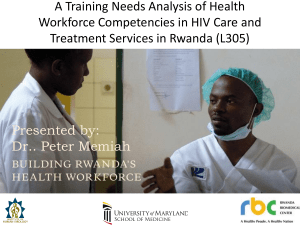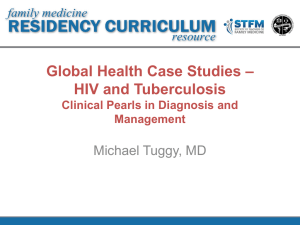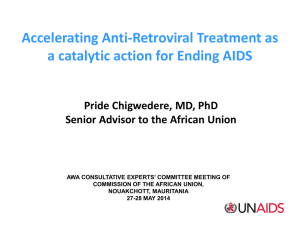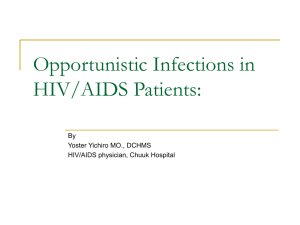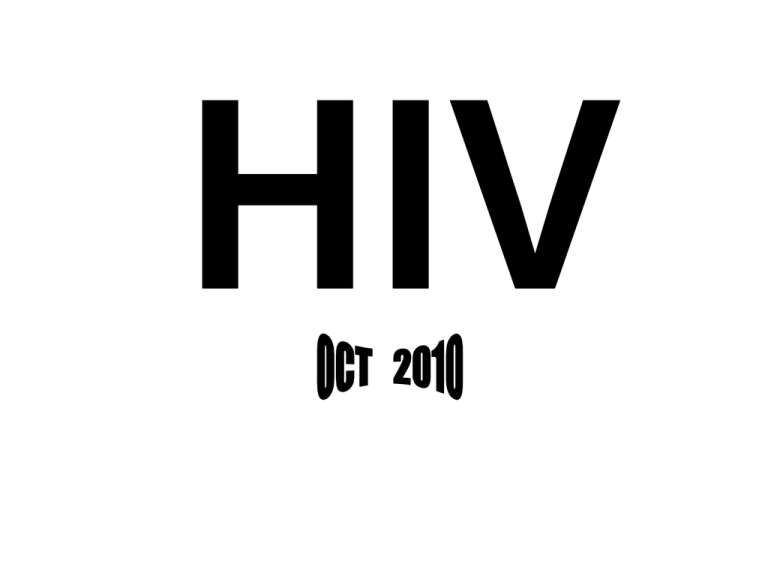
• HIV disease
o An infectious disease caused by HIV, a human retrovirus
o HIV disease should be viewed as a spectrum ranging from primary
infection, with
or without the acute syndrome, to an asymptomatic stage, to
advanced disease
characterized by profound immunodeficiency and susceptibility to
opportunistic
infections.
• AIDS
Etiology
Human retroviruses HIV-1 and HIV-2
• Family of human retroviruses (Retroviridae)
• Subfamily of lentiviruses
• RNA viruses whose hallmark is the reverse transcription of its genomic RNA to DNA by the
enzyme reverse transcriptase
• HIV-1 is the most common cause of AIDS worldwide.
• HIV-2 has been identified predominantly in western Africa.
o Small numbers of cases have also been reported in Europe, South America, Canada,
and the U.S.
o Has ~40% sequence homology with HIV-1
o More closely related to simian immunodeficiency viruses
o Worldwide
Heterosexual transmission is the most common mode of
infection.
o Male-to-female transmission is 8 times more efficient than
female to male.
o Receptive anal intercourse is a much more efficient mode of
transmission than oral
o The presence of other sexually transmitted diseases
significantly increases the risk of
transmission, especially those with genital ulceration.
o Lack of circumcision carries an increased risk of HIV infection.
o The association of alcohol consumption and illicit drug use with
unsafe sexual
behavior leads to an increased risk of sexual transmission of
HIV.
• Transmission by blood and blood products
o Although the virus can be identified from
virtually any body fluid, there is no
evidence that HIV can be transmitted as a result
of exposure to saliva, tears, sweat,
or urine.
o Transmission of HIV by a human bite can
occur but is rare.
Transmission by HIVHIV-tainted blood transfusions, blood products, or transplanted
o Intravenous drug users
Exposed to HIV while sharing injection paraphernalia, such as needles,
syringes, the water in which the drugs are mixed, or the cotton through which
drugs are filtered
Risk Factors
• Sexual transmission
o Homosexual and heterosexual contact with an
infected person
44% of new HIV/AIDS diagnoses in 2001–2004
were attributed to male-tomale
sexual contact.
34% of new HIV/AIDS diagnoses in 2001–2004
were attributed to
heterosexual contact.
Inside the Body
Major structural elements:
–Envelope
•gp120
•gp41
–HIV Core
•Structural proteins
–p24
•2 copies of single stranded RNA
•Enzymes
–Reverse transcriptase
–Integrase
–Protease
• HIV
• Structure
Typical Virus Components
Outer Covering
Inner Core
HIV Envelope
Envelope Proteins
(gp120 & gp41)
Lipid Bilayer
HIV Core
Integrase
Core Proteins
RNA genome
Reverse Transcriptase
Protease
HIV Replication
http://www.youtube.com/watch?v=RO8MP3wMvqg&feature=related
http://www.primeboost3.org/vaccine/images/knowledge/micro41[1].swf
http://www.sumanasinc.com/webcontent/animations/content/hiv.html
Viral Attachment
CD4 Receptors
gp120
Viral Fusion and Penetration
Viral RNA
Reverse Transcriptase
Reverse Transcription
Reverse Transcriptase
RNA
DNA
RNA
DNA
DNA
Integration into the Host Cell
Provirus
Transcription and Translation
Viral mRNA
exits Nucleus
Viral mRNA
gp160
Endoplasmic Reticulum
RNA Polymerase II
p160
Ribosome
Proviral DNA
p55
Protein Processing by the HIV
Protease
Viral Protease
Large polyproteins
(E.g. p16/ p55)
Smaller
Functional Strands
Assembly and Budding
Gag-pol (p160)
Gag (p55)
Gag (p55)
Gag-pol (p160)
Contact
HIV
Mucosa
Local Infection
HIV
Mucosa
CD4
Co Receptor
CD4+ Lymphocyte
Dendritic cell
Lymph Nodes
HIV
Mucosa
CD4
Co Receptor
CD4+ Lymphocyte
Dendritic cell
2 Days
Widespread Dissemination
HIV
Mucosa
CD4
Co Receptor
CD4+ Lymphocyte
2 Days
Dendritic cell
3 Days
Gut-associated Spleen
Lymphoidal tissue
Brain
Lymph
Nodes
How are HIV Reservoirs Formed?
Routes of infection in the
body:
• Peripheral
blood
Tissue
Gut-associated Spleen
Lymphoidal tissue
Brain
Lymph
Nodes
Where are HIV Reservoirs Found?
Brain
Skin
Lymph Nodes
RES
Peripheral Blood
Gastrointestinal Cells
Bone Marrow
Evading the Treatment Radar
Without
HIV Therapy
HIV
Reservoirs
Lymph Nodes Brain
HIV
Infected
Cells
Dendritic cells
Spleen Gut-associated
Lymphoid tissue
Macrophages
Non-activated
CD4 T cell
Activated
CD4 T cell
With
HIV Therapy
Relationship Between CD4 Cell Count and Viral Load
Health
Health
VL
CD4
Opportunistic Infections and CD4
Cell
Count
Natural Course of HIV Infection and Common Complications
VL
CD4+ T cells
Relative level of
Plasma HIV-RNA
TB
HZV
Asymptomatic
Acute HIV
infection
syndrome
OHL
PPE
OC PCP
TB
CMV, MAC
CM
Laboratory Diagnosis of HIV Infection
1)
Anti-HIV-1&2 Testings
- เริ่ มตรวจพบ สัปดาห์ที่ 3-12 หลังจากติดเชื้อ แทบทั้งหมดตรวจพบเดือนที่ 3….6
หลังจากติดเชื้อ
- ปัญหา การตรวจหาในระยะ Window period
1.1 Screening tests: ELISA,GPA,rapid test etc.
1.2 Confirmatory tests: Westem blot* (WB)
: Immunofluorescence
* In high prevalence area, 2-3 screening assays with
different principle in recommended as alternative to WB
2) Antigen detection: p24 Ag by ELISA
3) Gene detection: PCR, nested PCR, RT-PCR, Rrt-PCD
- Should amplified 3 regions and considered positive if at
least 2 regions are amplified
4) HIV culture
5 most common opportunistic infections
30
25
Tb
20
PCP
15
CCM
10
Candidiasis
5
0
Recurrent pn.
300
279
250
200
< 1998
150
ส.ค.-98
100
> 1999
50
40
8
0
Costly anti Ols drugs
CNS infection in HIV
•
•
•
•
•
Cryptococcal meningitis
Toxoplasmic encephalitis
Tuberculous meningitis/myelitis
Bacterial meningitis
Progressive multifocal
leucoencephalopathy (PML)
• CMV ventriculitis/polyradiculopathy
Manifestation of CNS OI in HIV
•
•
•
•
Headache
Alteration of consciousness
Focal neurodeficit
Dementia
GI infection in HIV
•
•
•
•
•
•
Bacteria : Salmonella
Mycobacteria : TB, MAC
Fungus: Histoplasma, P.marneffei
Virus: CMV, HSV
Parasites: Strongyloides, E.histolytica
Isospora, Cryptosporidium,
Cyclospora, Microsporidium
Manifestation of GI OI in HIV
•
•
•
•
•
Abdominal mass/pain
Lymphadenopathy
Peritonitis
Causes
TB, MAC most common
HIV-associated FUO
• Prolonged fever is common in AIDS patients
• The etiology varies with geography
(AIDS 16:909,2002)
• Frequency ↑ with ↓ CD4 ;and ↓ with HAART
(Eur J Clin Micro Inf Dis 21:137,2002)
Prolonged Fever in HIV-Infected Adult Patients in Northern
Thailand
• The study was conducted at Chaing Mai University
Hospital from January 2002 to March 2003.
• history of fever for at least two weeks.
• Initial investigations included complete blood analysis,
CD4+ lymphocyte counts , blood urea nitrogen, serum
creatinine and electrolytes, liver function tests, urinary
examination and/or culture, blood cultures for bacteria, and
chest roentgenogram.
J infect Dis AntimicrobAgents
2005:22:103-10
Etiology of prolonged fever
• The etiology of prolonged fever could be determined in 71
of 90 patients (78.9%)
• Infectious agent was identified as the cause in 70 of these
71 patients
• Non-Hodgkins lymphoma was the only diagnosis in the
remaining patient.
• Among 70 patients with infectious etiology
– 56 had a single etiology
– 13 had multiple infectious etiologies
J infect Dis AntimicrobAgents
2005:22:103-10
Etiology of prolonged fever
Mycobacterial infection
M. avium complex
M. tubeerculosis
M. scrofulaceum
Penicilliosis marneffei
Salmonellosis
Cryptococcosis
40 cases
117
11
5
16 cases
13 cases
7 cases
J infect Dis AntimicrobAgents
2005:22:103-10
Selective Pressures of
Therapy
Viral load
Treatment begins
Drug-susceptible quasispecies
Drug-resistant quasispecies
Selection of resistant
quasispecies
Incomplete suppression
• Inadequate potency
• Inadequate drug levels
• Inadequate adherence
• Pre-existing resistance
Time
Goal of Therapy
Viral load
Relative Levels
CD4
<50copies/mL at
6 month
Limit of Detection
Months
Acute HIV infection
Years After HIV Infection
Low-level Viral Rebound and ‘Blips’
HIV RNA (copies/mL)
Failure
Sustained
low-level viremia
50
Resuppression
Time
Greub G et al. 8th CROI 2001
Evolution of Antiretroviral
Therapy
Survival from age 25 years
Probability of Survival
1
Population controls
0.75
Late HAART
(2000-2005)
0.5
Early HAART
(1997-1999)
0.25
Pre-HAART (1995-1996)
0
25
30
35
40
45
50
55
60
65
Age, y
Lohse N, et al. Ann Intern Med 2007
70
Recalling the HIV Replication Cycle
Attachment
Fusion and
Penetration
Assembly and
Budding
Reverse
Transcription
Maturation
Integration
Transcription and
Translation
Protein Processing
Currently Approved Drug Classes
Attachment
Fusion/ Entry
Inhibitors
Fusion and
Penetration
Reverse
Transcription
Integrase
inhibitors
Assembly and
Budding
NRTI/ NNRTI
Maturation
Integration
Transcription and
Translation
Protease
Inhibitors
Protein Processing
Antiretroviral Agents 2010
NRTI
NNRTI
abacavir (ABC)
efavirenz (EFV)
atazanavir (ATV)
didanosine (ddI)
etravirine (ETR)
darunavir (DRV)
emtricitabine (FTC)
delavirdine (DLV)
fosamprenavir (FPV)
lamivudine (3TC)
nevirapine (NVP)
indinavir (IDV)
stavudine (d4T)
tenofovir (TDF)
zidovudine (AZT)
Integrase Inhibitors
raltegravir (RAL)
Entry Inhibitor
enfuvirtide (T20)
CCR5 Antagonists
maraviroc (MVC)
PI
lopinavir/r (LPV/r)
nelfinavir (NFV)
ritonavir (RTV)
saquinavir (SQV)
tipranavir (TPV)
When Is Antiretroviral Therapy
Started?
Review of data from 2003-2005 from 176 sites in 42 countries (N = 33,008)
Since 2000, CD4+ cell count at initiation in developed countries stable at
approximately 150-200 cells/mm3, increasing in sub-Saharan Africa from
50-100 cells/mm3
164
200 179
187
123
102
181
Egger M, et al. CROI 2007. Abstract 62.
125 86
122 100
97
97
87
163
192
157 206
103 53 95
72 134
239
BHIVA Guidelines for initiation of ARV 2006
Presentation
Surrogate markers
Symptomatic
Any CD4 count or viral
disease or AIDS
load
Established
infection
CD4 <200, any viral load
CD4 201-350
CD4 >350
Primary HIV
infection
Recommendation
Treat (AI)
Treat (AI)
Start Rx, taking into
account viral load
(BIII), rate of CD4
decline (BIII),
patient’s wishes,
presence of HCV
(CIV)
Defer Rx
Rx only recommended
in a clinical trial, or
if severe illness
(CIV)
HIV Medicine (2006), 7, 487-503
Thai MOPH Guideline 2007 – When to Treat
อาการทางคลินิก
ระดับ CD4 (เซลล์/
ลบ.มม.)
คาแนะนา
มีความเจ็บป่วยของ
ระยะเอดส์
(AIDS-defining
illness)*
เท่าใดก็ตาม
เริ่มยาต้านเอชไอวี
มีอาการ**
เท่าใดก็ตาม
เริ่มยาต้านเอชไอวี
ไม่มีอาการ
< 200
เริ่มยาต้านเอชไอวี
ไม่มีอาการ
200 – 350
ยังไม่เริ่มยาต้านเอชไอวี
ให้ติดตามอาการและตรวจระดับ
CD4 ทุก 3 เดือน
ไม่มีอาการ
> 350
ยังไม่เริ่มยาต้านเอชไอวี
ให้ติดตามอาการและตรวจระดับ
CD4 ทุก 6 เดือน
แนวทางการดูแลรักษาผู้ติดเชื้อเอช ไอ วี และผู้ป่วยเอดส์ในประเทศไทยปี พ.ศ. 2549/50
กรมควบคุมโรค กระทรวงสาธารณสุข สมาคมโรคเอดส์แห่งประเทศไทย สมาคมโรคติดเชื้อในเด็ก
*CDC: AIDS-defining illness
•
•
•
•
•
•
•
•
•
•
•
•
•
Candidiasis of bronchi, trachea, or lungs
Candidiasis, esophageal
Cervical cancer, invasive
Coccidioidomycosis, disseminated or
extrapulmonary
Cryptococcosis, extrapulmonary
Cryptosporidiosis, chronic intestinal (> 1
month)
Cytomegalovirus disease (other than liver,
spleen, or nodes)
Cytomegalovirus retinitis (with loss of
vision)
Encephalopathy, HIV-related
Herpes simplex: chronic ulcer(s) (> 1
month); or bronchitis, pneumonitis, or
esophagitis
Histoplasmosis, disseminated or
extrapulmonary
Isosporiasis, chronic intestinal (> 1 month)
Kaposi’s sarcoma
•
•
•
•
•
•
•
•
•
•
•
•
Lymphoma, Burkitt’s (or equivalent term)
Lymphoma, immunoblastic (or equivalent)
Lymphoma, primary, of brain
Mycobacterium avium complex or M.
kansasii, disseminated or extrapulmonary
Mycobacterium tuberculosis, any site
(pulmonary or extrapulmonary)
Mycobacterium, other species or
unidentified species, disseminated or
extrapulmonary
Pneumocystis pneumonia
Pneumonia, recurrent
Progressive multifocal
leukoencephalopathy
Salmonella septicemia, recurrent
Toxoplasmosis of brain
Wasting syndrome due to HIV
Thai added Penicillosis
** อาการดังกล่าวได้แก่
เชื้อราในปาก
ตุ่มคันทั่วตัวโดยไม่ทราบสาเหตุ (pruritic popular
eruptions: PPE)
ไข้เรื้อรังไม่ทราบสาเหตุ
อุจจาระร่วงเรื้อรังที่ไม่สามารถหาสาเหตุได้นานเกิน
14 วัน
น้าหนักลดมากกว่าร้อยละ 10 ใน 3 เดือน
Situation in National AIDS Program, Thailand.
Cumulative Patients on 1st and 2nd Line ARV
160000
6,470
2nd line
regimens
4.54%
140000
120000
135,809
100000
2nd line regimens
1st line regimens
80000
60000
40000
20000
De
c.
06
M
ar
.0
7
Ju
n.
07
Se
p.
07
De
c.
07
M
ar
.0
8
Ju
n.
08
Se
p.
08
De
c.
08
M
ar
.0
9
Ju
n.
09
Se
p.
09
De
c.
09
M
ar
.1
0
0
National Health Security Office (NHSO) Thailand
Data at 7 Mar 2010
When to Start Antiretroviral Therapy
Late clinical stages
Early Clinical Stages
< 200
> 500
200
350
Any viral load
High Viral load
CD4
Schechter, 2004 (JID 2004;190:1043-1045)
Draft Thai ART Guidelines 2010
(Adult1)
Clinical
Presentations
CD4
(cells/mm3)
Recommendations
AIDS-defining illness
Any
Treat
HIV-related Symptomatic
Any
Treat
Asymptomatic
<350
Treat
Asymptomatic
>350
Pregnancy
Any
Defer Rx, follow clinical status and CD4
every 6 months
Treat, discontinue ARV after delivery if
pre-treat CD4 >350 cells/mm3
Special consideration for ART initiation
• HBV or HCV co-infection: any CD4 if treatment of HBV or HCV needed
• Age >50: CD4 350-500 with at least one of these following conditions
(DM, HT, Dyslipidemia)
Bureau of AIDS,TB, and STIs and Thai AIDS Society (TAS)
ยาต้านไวรัสเอชไอวี
การรักษาโรคติดเชื้อเอชไอวีด้วยยาต้ านไวรัส เป็ นส่ วนที่สาคัญ
ที่สุดในบรรดาทั้งหมดของการดูแลรักษาผู้ป่วยติดเชื้อเอชไอวี การ
ใช้ ยาต้ านไวรัสเอชไอวีอย่ างน้ อย 3 ตัวร่ วมกันตามสู ตรยาต้ านไวรัส
ที่ มี ก ารศึ ก ษาไว้ ว่ า มี ป ระสิ ท ธิ ภ าพหรื อ ที่ เ รี ย กว่ า HAART
(highly active antiretroviral therapy)
สามารถลดปริ มาณไวรั สเอชไอวีให้ อยู่ในปริ มาณที่น้อยจนวัดไม่ ได้
(undetectable level) และทาให้ ปริมาณ CD4
สู งขึน้ ส่ งผลให้ อุบัติการณ์ ของโรคติดเชื้อแลหะอัตราการลดลงอย่ าง
ชัดเจน และผู้ป่วยมีคุณภาพชีวติ ทีด่ ีขนึ้
Original ARV launching in Thailand : 19872002
NFV
IDV
AZT
1987
ddc
3Tc
RTV
EFV
ddI
d4T
SQV
NVP
96
98
00
LPV
ATV
02
04
The changing Views :
National HIV/AIDS
policies
Social insurance
ATC, NAPHA project
3x5 project
MTC programme
MOPH clinical trail
AZT supply
90
94
96
98
00 02
UC scheme 2006
04
1.Reduced d4T
3. Non Thymidine based regimen
2. GPO Z 250 = AZT+3TC+NVP
Considerations in the Selection of Combination
Regimens
1.
2.
3.
4.
Synergy
Lack of cross-resistance
Lack of overlapping toxicity
Favorable pharmacokinetics, lack of drugdrug interactions
5. Favorable interaction of resistance
mutations
6. Base of co-administration
7. Cost
ในรายทีไ่ ม่ มีอาการควรจะเริ่มเมือ่ มีอาการ CD4 ต่ากว่ า 200-250 ตัว/มคล
1. ทาความรู้ จกั ผู้ป่วยทั้งในเรื่องรายได้ อาชีพ และเวลาทางาน
2. ถ้ าผู้ป่วยยังไม่ แน่ ใจหรือไม่ มั่นใจว่ าจะกินยา
3. ประเมิ น ผู้ ป่ วยอย่ า งละเอี ย ดทั้ ง การซั ก ประวั ติ แ ละการตรวจ
ร่ างกาย เพือ่ ให้ แน่ ใจว่ าไม่ ได้ กาลังมีโรคติดเชื้อฉวยโอกาส
ปัจจัยที่มีผลทาให้ การรักษาด้ วยยาต้ านไวรัสล้ มเหลว
1. ประสิ ทธิภาพของยาทีใ่ ห้ ไม่ ดีพอ (insufficient antiviral
potency)
2. ผู้ป่วยกินยาไม่ สม่าเสมอ (poor adherence)
3. ปัจจัยทางเภสั ชวิทยา (pharmacologic and
pharmacokinetic factors)
4. ระยะของโรคติดเชื้อเอชไอวีที่เป็ นมากแล้ว (advanced disease)
5. การดือ้ ยาทีม่ ีอยู่ก่อน (pre-existing mutation)
How to Monitor ART
1. Clinical : AIDS-related illness
2. CD4+ cell counts
<200 : PCP prophylaxis
<100 : Crytococcal prophylaxis
<70 : CMV , MAC prophylaxis (Costly!!)
3.
4.
5.
6.
Viral load (Plasma HIV-RNA)
Adherence
Potential drug interaction
Quality of life
Laboratory monitoring of
ART
• General assessment
CBC, LFT (SGOT/SGPT), amylase, Creatinine
• Immunological assessment
CD4+ count
• Virological assesment
plasma HIV-RNA (Viral load)
proviral HIV-DNA quantitation
HIV drug resisstance genotyping
• Assessment for latent of reactivated
infection esp., TB and Ols
Chest X-ray, tuberculin test, others:
cryptococcal Ag, toxoplasma Ab etc.
วัตถุประสงค์การตรวจหา CD4 cell count
•
•
•
•
ติดตามผลการตอบสนองต่อรักษา
ทานายความรุ นแรงของโรค
ช่วยแพทย์ตดั สิ นใจในการเริ่ มรักษา ART
ช่วยแพทย์ตดั สิ นใจในการให้ OI prophylaxis
ปัจจัยที่ส่งผลกระทบต่อค่า CD4+ T cell
1. โรคติดเชื้อบางชนิด ทาให้ค่า CD4 ต่าลงชัว่ คราว และ/หรื อ
CD4 สูงขึ้น
2. Mental stress
WBC
3. ได้รับยา corticosteroid
CD4
HIV viral load (HIV VL)
• VL คือ การตรวจหาปริ มาณ HIV-RNA ที่พบในแต่ละ
มิลลิลิตรของพลาสม่า โดยรายงานผลเป็ น RNA
copies/ml หรื อ ค่า log 10 ของ RNA copies/ml
• เป็ นการตรวจหาปริ มาณเชื้อไวรัสทางอ้อม (Piatak et al,
1993)
-VLs represent 99.99 % to 99.9999
% non-infectious viruses
• จากการวิเคราะห์ผปู ้ ่ วยมากกว่า 5000 ราย จาก 18 รายงาน พบว่า
มีความสัมพันธ์ชดั เจนระหว่างการลดลงของ VL กับผลการรักษา
ทางคลินิก เช่น มีผปู ้ ่ วย AIDS น้อยลง และอัตราการรอดชีวิต
เพิ่มขึ้น ไม่วา่ ผูป้ ่ วยจะมี viral load และ CV4 ระดับใด
วัตถุประสงค์การตรวจหา HIV viral load
• เพื่อทานายความรุ นแรงของโรค
• เพือ่ ช่วยแพทย์ตดั สิ นในใจการรักษา
• เพือ่ ช่วยประเมินประสิ ทธิภาพของ ART และ natural
product
• เพื่อติดตามผลการรักษา และการปรับเปลี่ยน ART
• ช่วยประเมินผลการดื้อยา
Viral Load : Plasma HIV-1 RNA
Company
Test
Sensitivity
(copies/ml)
Roche
Amplicor TM
Ultrasens
Quantiplex v3.0
Nuclisens v1.0
Nuclisens (real time)
Taqman (real time)
400
50
50
500
50
40
Bayer
Organon
Organon
Roche
Dynamic Range (co
(copies/ml)
400 to 750,000
50 to 75,000
50 to 500,000
400 to 10,000,000
50 to 30,000,000 (IU/ml)
40 to 30,000,000 (IU/ml)
Note: Amplicor ~ Nuclisens > Bayer ~ 2 fold
: current acceptable variation within the same test up to 3 fold esp. Very high VL
อัตราการลดลงของ HIV VL จะช้าหรื อเร็ ว ขึ้นอยูก่ บั
• ปริ มาณ VL ก่อนการได้รับยา (based line หรื อ set
point)
• ชนิดและคุณสมบัติของเชื้อที่ได้รับ
• สภาพภูมิคุม้ กันร่ างกายที่แตกต่างได้ในแต่ละบุคคล
• ประสิ ทธิภาพของยาต้านไวรัสและแบบแผนการรับยา
• ความต่อเนื่องของการใช้ยา
• ระยะเวลาของการติดเชื้อ
• การติดเชื้อฉวยโอกาสอื่น
แนวทางการประเมินประสิ ทธิภาพยาตามแบบแผนการ
รักษา
• ยาที่ได้รับผลดี : ระดับ VL จะลดลงอย่างต่อเนื่องจนถึงระดับ
undetectable (<50 copies/ml)
• ยาไม่ได้ผล หรื อ เชื้อดื้อยา : ระดับ VL จะไม่ลดลงหรื อลดลงไม่มี
นัยสาคัญควรตรวจ VL ซ้ า ตรวจการดื้อยา พิจารณาร่ วมกับอาการ
ทางคลินิกในการเปลี่ยนยา
• หากปริ มาณ VL ลดลง หรื อ ระดับ undetectable แล้ว
กลับเพิ่มขึ้นควรตรวจ VL ซ้ า ตรวจการดื้อยา พิจารณาร่ วมกับ
อาการทางคลินิกในการปรับเปลี่ยน
การดื้อยาต้านไวรัสของเชื้อ HIV-1
ภาวะที่ยาต้ายไวรัสไม่สามารถยับยั้งการเพิ่มจานวนของเชื้อไวรัสได้ต่อไปโดย
การดื้อยาอาจเกิดกับยาเพียงตัวเดียว หรื อหลายตัวในกลุ่มยาที่ใช้
สิ่ งบ่งชี้วา่ อาจมีเชื้อ HIV ดื้อยาต้านไวรัส
1. จากเดิม undetectable VL แล้วกลับมาเพิ่มจานวนใหม่อีกจนมีระดับ
> 10,000 copies//ml
2. อาการทางคลินิกของผูป้ ่ วย HIV/AIDS ยังคงอยู่ แม้วา่ กาลังรับยา
3. CD4+ T cell ลด แต่ VL ไม่ลด/เพิ่ม
-
Postexposure prophylaxis (PEP)
• Occupational exposure
- Percutaneous exposure needle stick
- Mucous membrane exposure
- Non – intact skin exposure
• Non – occupational
exposure
- Sexual exposure
- Consensual - Sexual assault (rape)
- Others – IVDU, Bite, Needle stick
Risk of HIV Infection
1.
2.
3.
Probability of HIV infection in source person
Character of exposure
• Type of exposure
• Type and amount of exposed body
fluid
• Amount of HIV in exposed body fliuid
Risk of HIV transmission
Type of Occupational Exposure
• Percutaneous exposure
• Mucous membrane exposure
• Non – intact skin exposure
Type of Non-Occupational Exposure
• Sexual exposure
– consensual or assault (rape)
– anal or vaginal or oral
– receptive or insertive
– ejaculation VS no ejaculation
– condom use
• IVDU
• Others:- Percutaneous exposure, bite
Infectious Body Fluids
Definitely
Infectious
Potentially
Infectious
Not infectious
Unless visibly
bloody
Blood
Semen
Vaginal secretion
CSF
Synovial fluid
Pleural fluid
Peritoneal fluid
Pericardial fluid
Amniotic fluid
Pus
Feces
Urine
Nasal secretion
Sputum
Sweat
Tears
Vomitus
Any visibly
bloody fluid
Amount of HIV in
Exposed Body Fluid
• ↑ Plasma HIV – RNA → ↑ Risk of transmission
But undetectable plasma HIV RNA does not mean “no
transmission”
- Only measure extracellular HIV
- Dose not absolutely correlate with HIV in other
body fluid including semen and vaginal fluid
Management of
Occupational Exposure
•
•
•
•
•
•
•
•
Immediate decontamination of involved region
Reporting the incident
Counseling
Risk assessment
Assessment of source patient
Assessment of exposed HCW
Consideration and provision of PEP
Follow up and monitoring
Risk Assessment
Assess risk for HIV infection
• Type and severity of exposure
: Percutaneous injuries
• Less severe : solid needle or superficial injury
• More severe : large-bore hollow needle, deep
puncture, visible blood on device, needle used in
patient’s artery or vein
: Mucous membrane or Non-intact skin exposures
• Small volume : a few drops
• Large volume : major splash
Risk Assessment
Assess risk for HIV infection
• Infection status of source
– Class 1 : asymptomatic HIV infection or known low viral load
(<1500 copies RNA/mL)
– Class 2 : symptomatic HIV, AIDS, acute seroconversion, or
khow high viral load
Risk Assessment
Other Likely Risk factors
• ↑ HIV viral load (> 1,500 RNA copies/mL)1
• Glove use – 50% decrease in volume of blood
transmitted2
• Hollow bore VS Solid bore needle
- Hollow bore needle > suture needle 3
- Large diameter needles ( < 23 guage)
increased risk (p = 0.08) 4

